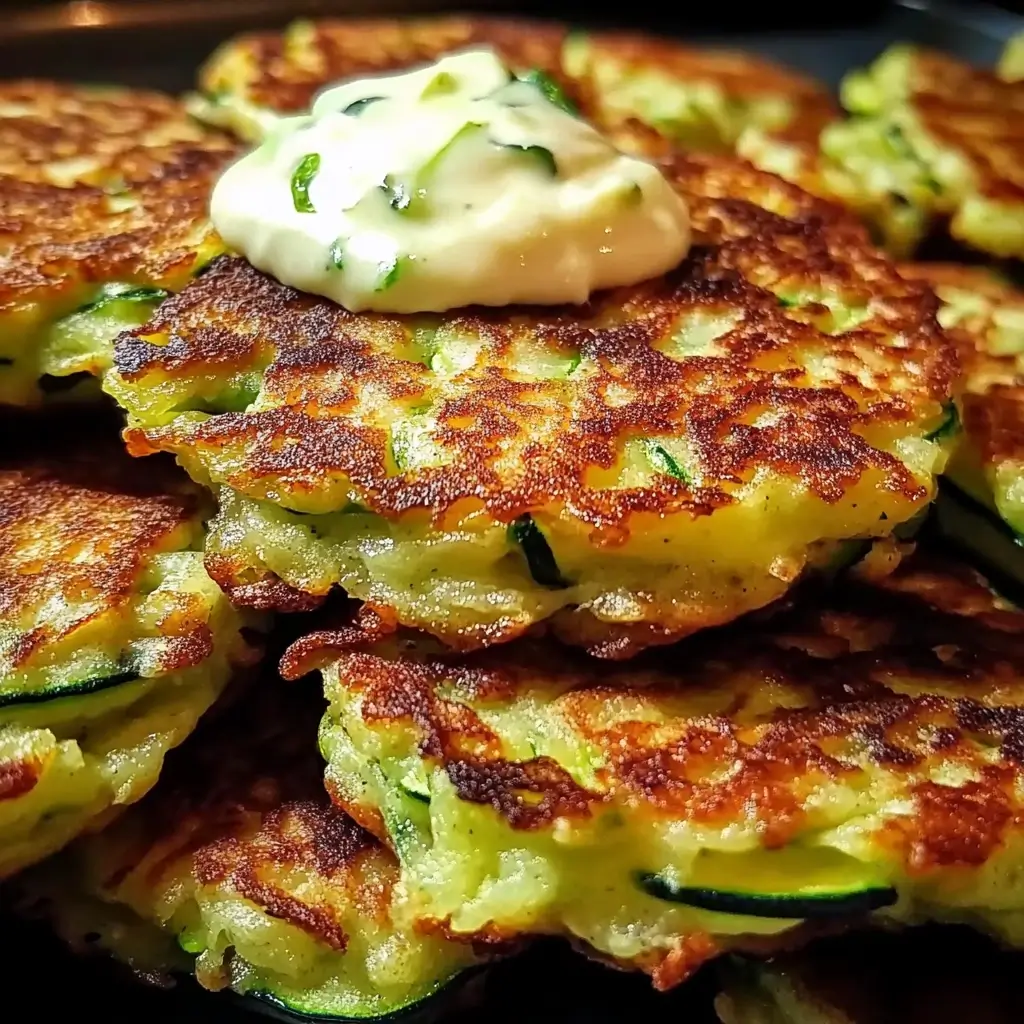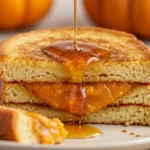In my kitchen, weeknight dinners are often a dance between quick, easy, and something everyone will actually eat. Let’s be honest, getting vegetables into kids (and sometimes even adults!) can be a challenge. That’s why zucchini fritters have become a total game-changer in our household. The first time I made these, I was honestly skeptical. Could grated zucchini actually transform into something crispy and crave-worthy? The answer, unequivocally, is YES! The magic lies in the simple yet clever technique of drawing out excess moisture from the zucchini before mixing it into a flavorful batter. The result is a fritter that boasts a satisfyingly crispy exterior, giving way to a tender, almost creamy interior. My kids, who are usually lukewarm about zucchini, devour these. They’re perfect as a light lunch, a fun appetizer for guests, or even a side dish that elevates a simple grilled chicken or fish dinner. And the best part? They are surprisingly easy to make, using ingredients you likely already have in your pantry and fridge. Whether you’re looking for a creative way to use up summer zucchini, or simply want a delicious and slightly healthier alternative to fried snacks, these zucchini fritters are a must-try. They’re vegetarian, adaptable for low-carb diets, and endlessly customizable with your favorite herbs and spices. Get ready to discover your new favorite way to enjoy zucchini – crispy, tender, and utterly delicious!
Ingredients for Perfect Zucchini Fritters
The beauty of this zucchini fritter recipe lies in its simplicity and the readily available ingredients. Each element plays a crucial role in achieving that perfect balance of crispy exterior and tender interior. Let’s break down each ingredient and understand its purpose in creating these delightful fritters:
- 2 medium zucchinis, grated: Zucchini is, of course, the star of the show. Medium-sized zucchinis are ideal as they are tender and have fewer large seeds. When grating, aim for a medium shred. Too fine, and they might become mushy; too coarse, and they might not bind together as well. Remember, fresh, firm zucchini will yield the best results. If your zucchini is a bit older and softer, it might contain more moisture, so be extra diligent with the salting and squeezing step later on.
- 1 teaspoon salt: Salt is not just for flavor in this recipe; it’s a crucial tool for drawing out excess moisture from the grated zucchini. This step is non-negotiable for achieving crispy fritters. The salt works through osmosis, pulling water out of the zucchini cells. Using the correct amount of salt is important – too little and you won’t remove enough moisture; too much, and your fritters could become overly salty. A teaspoon is generally perfect for two medium zucchinis.
- 1/4 cup all-purpose flour (or almond flour for a low-carb option): Flour is the binding agent in our fritter batter. All-purpose flour provides a classic texture, creating fritters that are both crispy and slightly chewy. However, for those following a low-carb or gluten-free diet, almond flour is an excellent substitute. Almond flour will yield fritters that are slightly nuttier in flavor and perhaps a bit more delicate. You may need to adjust the amount slightly depending on the moisture content of your zucchini after squeezing. If the batter seems too wet with almond flour, you can add a tablespoon or two more.
- 1/4 cup grated Parmesan cheese (optional for extra flavor): Parmesan cheese is an optional but highly recommended ingredient for adding a savory, umami depth to the fritters. The saltiness and nutty flavor of Parmesan complement the mild zucchini beautifully. Use freshly grated Parmesan for the best flavor and melting quality. If you are dairy-free or prefer a different flavor profile, you can omit the Parmesan or try nutritional yeast for a cheesy, vegan alternative. Other hard cheeses like Pecorino Romano or Grana Padano would also work well.
- 2 green onions, finely chopped: Green onions, also known as scallions, provide a mild oniony flavor and a touch of freshness to the fritters. Finely chopping them ensures they distribute evenly throughout the batter and cook through properly. If you don’t have green onions, you could substitute with a small amount of finely minced shallot or even a tablespoon of finely chopped chives.
- 1 egg, lightly beaten: The egg acts as another binder, helping to hold the fritter mixture together and adding richness and moisture. Lightly beating the egg before adding it to the mixture ensures it incorporates evenly. For a vegan alternative, you could experiment with flax eggs (1 tablespoon flaxseed meal mixed with 3 tablespoons water, let sit for 5 minutes to thicken), although this might slightly alter the texture of the fritters.
- 1/2 teaspoon garlic powder (optional): Garlic powder is an optional but delicious addition that enhances the savory flavor of the fritters. It provides a subtle background note that complements the zucchini and Parmesan (if using). You can adjust the amount to your liking or substitute with fresh minced garlic if you prefer a stronger garlic flavor. If using fresh garlic, sauté it lightly in a bit of olive oil before adding it to the batter to mellow its raw edge.
- 1/4 teaspoon black pepper: Black pepper is essential for seasoning and adding a touch of warmth to the fritters. Freshly ground black pepper is always preferred for the best flavor. Adjust the amount to your taste preference. You could also experiment with other spices like a pinch of red pepper flakes for a little heat, or a dash of smoked paprika for a smoky flavor.
- 2 tablespoons fresh parsley or dill, chopped (optional): Fresh herbs add brightness and freshness to the fritters. Parsley and dill are classic choices that pair well with zucchini and Parmesan. Choose whichever herb you prefer, or use a combination of both. Other fresh herbs that would work well include chives, mint, or even a bit of finely chopped basil. Make sure to chop the herbs finely so they distribute evenly and release their flavor throughout the fritters. If you don’t have fresh herbs on hand, you can use dried herbs, but reduce the amount to about 1 teaspoon as dried herbs have a more concentrated flavor.
- Vegetable oil, for frying: Vegetable oil is recommended for frying because it has a neutral flavor and a high smoke point, making it ideal for shallow frying. Other oils with a high smoke point, such as canola oil, grapeseed oil, or even light olive oil, would also work. Avoid using olive oil with a strong flavor or butter, as they have lower smoke points and might burn at the frying temperature. You need enough oil to cover the bottom of the skillet, about ¼ to ½ inch deep.
Step-by-Step Instructions for Making Crispy Zucchini Fritters
Making zucchini fritters is a straightforward process, but paying attention to each step will ensure you achieve that perfect crispy and tender texture. Here’s a detailed guide to walk you through each stage:
- Prepare the zucchini: Grate the zucchinis and place them in a colander. Sprinkle with 1 teaspoon of salt and toss to combine. Let the zucchini sit for 10-15 minutes to draw out excess moisture. This is the most crucial step for crispy fritters. Start by washing and trimming the ends of your zucchinis. Using a box grater or food processor with a grating attachment, grate the zucchinis. Place the grated zucchini in a colander set over a bowl or in the sink. Evenly sprinkle the teaspoon of salt over the grated zucchini and toss it gently to ensure the salt is distributed. Let the zucchini sit for 10-15 minutes. You will notice moisture being drawn out of the zucchini and collecting in the bowl beneath the colander. This salting process is essential for preventing soggy fritters. Don’t skip this step!
- Use a clean kitchen towel or paper towels to squeeze out as much water as possible. After the zucchini has sat for 10-15 minutes, it’s time to remove the excess moisture. Take handfuls of the salted zucchini and squeeze them firmly over the colander or sink to extract as much water as you can. You can use a clean kitchen towel or sturdy paper towels for this. If using a kitchen towel, gather the zucchini in the center of the towel, twist the towel tightly, and squeeze hard to wring out the water. Repeat this process until you have squeezed all the zucchini. You’ll be surprised how much water comes out! The drier the zucchini, the crispier your fritters will be. Don’t be afraid to squeeze firmly; you want to remove as much moisture as possible.
- Make the fritter mixture: In a large bowl, combine the grated zucchini, flour, Parmesan cheese (if using), green onions, beaten egg, garlic powder, black pepper, and fresh parsley or dill. Mix until well combined. In a large mixing bowl, add the squeezed zucchini. Then, add the flour (all-purpose or almond flour), grated Parmesan cheese (if using), finely chopped green onions, lightly beaten egg, garlic powder, black pepper, and chopped fresh parsley or dill. Gently mix all the ingredients together until just combined. Be careful not to overmix, as this can develop the gluten in all-purpose flour, resulting in tougher fritters. The mixture should be moist but not overly wet. If it seems too wet, you can add a tablespoon more of flour, but aim for a consistency that holds together when spooned but is not dry.
- Form the fritters: Heat a large skillet over medium heat and add enough vegetable oil to cover the bottom of the pan. Once the oil is hot, scoop spoonfuls of the zucchini mixture into the skillet, flattening each fritter slightly with the back of the spoon. Place a large skillet (cast iron or non-stick works well) over medium heat. Add enough vegetable oil to the skillet to cover the bottom, about ¼ to ½ inch deep. Heat the oil until it is shimmering hot. You can test if the oil is ready by dropping a tiny bit of the fritter mixture into the oil; if it sizzles immediately, the oil is hot enough. Using a spoon or a small ice cream scoop, scoop spoonfuls of the zucchini mixture into the hot oil. Leave some space between each fritter to avoid overcrowding the pan. Once you’ve placed the fritters in the skillet, use the back of a spoon or a spatula to gently flatten them slightly. This helps them cook evenly and become crispy.
- Cook the fritters: Cook the fritters for about 3-4 minutes on each side, or until golden brown and crispy. Avoid overcrowding the pan—cook in batches if needed. Transfer the fritters to a paper towel-lined plate to drain excess oil. Cook the fritters for 3-4 minutes on each side, or until they are golden brown and crispy. The cooking time may vary slightly depending on the heat of your pan and the thickness of the fritters. Keep an eye on them and adjust the heat if needed. If they are browning too quickly, reduce the heat to medium-low. Avoid overcrowding the pan, as this will lower the oil temperature and result in soggy fritters. Cook the fritters in batches if necessary. Once the fritters are cooked, carefully remove them from the skillet using a spatula and transfer them to a plate lined with paper towels. This will help to absorb any excess oil and keep them crispy.
- Serve: Serve the Zucchini Fritters hot, with a side of sour cream, Greek yogurt, or your favorite dipping sauce. Zucchini fritters are best enjoyed hot and fresh when they are at their crispiest. Serve them immediately as a snack, appetizer, or side dish. They pair wonderfully with a variety of dipping sauces. Sour cream, Greek yogurt, ranch dressing, tzatziki sauce, or even a simple marinara sauce are all delicious options. Garnish with extra fresh herbs, a sprinkle of Parmesan cheese, or a squeeze of lemon juice for added flavor and visual appeal.
Nutrition Facts for Zucchini Fritters
(Note: Nutritional information is an estimate and can vary based on specific ingredients and serving sizes)
Servings: 10-12 fritters
Serving Size: Approximately 2 fritters
Estimated Nutritional Information per Serving (approx. 2 fritters):
- Calories: 150-200 kcal
- Protein: 5-7g
- Fat: 10-14g
- Saturated Fat: 2-4g
- Cholesterol: 30-40mg
- Sodium: 200-300mg (depending on added salt and Parmesan)
- Carbohydrates: 10-15g
- Fiber: 2-3g
- Sugar: 2-3g
- Net Carbs: 8-12g (if using all-purpose flour)
Key Nutritional Highlights:
- Good source of Vitamin K: Zucchini is a decent source of Vitamin K, important for blood clotting and bone health.
- Source of Vitamin C: Zucchini also provides some Vitamin C, an antioxidant that supports the immune system.
- Low in Calories: Compared to many fried snacks, zucchini fritters can be a relatively lighter option, especially when baked or air-fried (though this recipe focuses on pan-frying for crispiness).
- Vegetarian-Friendly: This recipe is naturally vegetarian, making it a great option for meat-free meals.
- Fiber Content: Zucchini contributes dietary fiber, which aids digestion and promotes satiety.
Note: Using almond flour instead of all-purpose flour will reduce the carbohydrate content and increase the protein and healthy fat content, making it suitable for lower-carb diets. Omiting Parmesan cheese will reduce the fat and sodium content and make the recipe dairy-free. Pan-frying adds fat; baking or air-frying can significantly reduce the fat content if you are looking for a lighter version.
Preparation Time for Zucchini Fritters
- Prep Time: 20 minutes (includes grating zucchini and draining moisture)
- Cook Time: 20 minutes (approximately, depending on batch size)
- Total Time: 40 minutes
This recipe is relatively quick to make, perfect for a weeknight meal or a last-minute appetizer. The majority of the prep time is spent grating the zucchini and letting it drain, which is mostly hands-off. The actual cooking process is fast, especially if you work in batches to avoid overcrowding the pan.
How to Serve Zucchini Fritters
Zucchini fritters are incredibly versatile and can be served in numerous ways. Here are some delicious serving suggestions:
- As an Appetizer:
- Classic Dip Platter: Serve them hot with a selection of dips like sour cream, Greek yogurt, ranch dressing, tzatziki sauce, hummus, or baba ghanoush.
- Mini Fritter Bites: Make smaller fritters and arrange them on a platter with toothpicks for easy grabbing.
- Caprese Fritters: Top each fritter with a slice of fresh mozzarella, a cherry tomato half, and a basil leaf for a Caprese-inspired appetizer.
- Smoked Salmon Topped: Top with a dollop of cream cheese or dill cream cheese and a small piece of smoked salmon for a more elegant appetizer.
- As a Side Dish:
- Alongside Grilled Meats or Fish: Zucchini fritters make a fantastic side dish for grilled chicken, steak, salmon, or shrimp. Their crispy texture and savory flavor complement grilled dishes beautifully.
- With Roasted Vegetables: Pair them with roasted vegetables like bell peppers, onions, asparagus, or broccoli for a complete and balanced vegetarian meal.
- Part of a Mezze Platter: Include zucchini fritters in a Mediterranean-style mezze platter with olives, pita bread, feta cheese, and other dips and spreads.
- With Eggs for Brunch: Serve them alongside scrambled eggs, poached eggs, or an omelet for a delicious and satisfying brunch.
- As a Snack:
- Quick Afternoon Bite: Enjoy them as a satisfying afternoon snack. They are much healthier than many processed snacks and provide a good dose of vegetables.
- Lunchbox Treat: Pack them in lunchboxes (they are best when reheated or eaten at room temperature, though slightly less crispy).
- Game Day Snack: Serve them as a fun and crowd-pleasing snack during game days or parties.
- Dipping Sauce Ideas:
- Classic Sour Cream or Greek Yogurt: Simple and always delicious. Add a squeeze of lemon juice or chopped chives for extra flavor.
- Garlic Aioli: A creamy and garlicky dip that complements the fritters perfectly.
- Spicy Mayo: Mix mayonnaise with sriracha or your favorite hot sauce for a spicy kick.
- Tzatziki Sauce: A refreshing Greek yogurt and cucumber dip.
- Marinara Sauce: Warm marinara sauce provides a comforting and familiar dipping option.
- Pesto: A vibrant and flavorful pesto adds a herbaceous touch.
- Honey Mustard: A sweet and tangy honey mustard dressing.
Additional Tips for Perfect Zucchini Fritters
To ensure your zucchini fritters are consistently delicious and crispy, here are five essential tips:
- Don’t Skip the Salting and Squeezing: This cannot be stressed enough! Removing excess moisture from the zucchini is the key to preventing soggy fritters. The salt helps draw out the water, and squeezing ensures you get rid of as much liquid as possible. Take your time with this step; it makes a huge difference in the final texture. Squeeze until you feel like you can’t get any more water out.
- Don’t Overcrowd the Pan: When frying the fritters, avoid overcrowding the skillet. Overcrowding lowers the oil temperature, which can lead to fritters absorbing too much oil and becoming greasy and soggy. Cook in batches, leaving enough space between each fritter for even cooking and browning. Patience is key – cooking in batches ensures each fritter gets crispy.
- Maintain the Right Oil Temperature: The oil temperature should be hot enough to cook the fritters quickly and make them crispy, but not so hot that they burn on the outside before cooking through on the inside. Medium heat is generally ideal. If the fritters are browning too quickly, reduce the heat slightly. If they are not browning enough, increase the heat a bit. You can use a thermometer to ensure the oil temperature stays around 350-375°F (175-190°C), but observing how the fritters cook is usually sufficient.
- Adjust Batter Consistency if Needed: The consistency of the batter should be moist but not too wet. If your zucchini was particularly watery, or if you are using almond flour, you might need to adjust the batter. If the batter seems too wet and runny, add a tablespoon more of flour at a time until it reaches a spoonable consistency. If it seems too dry, you can add a tiny bit of beaten egg or a tablespoon of milk or water to loosen it up. The goal is a batter that holds its shape when spooned into the hot oil.
- Serve Immediately for Best Crispness: Zucchini fritters are at their absolute best when served hot and fresh right out of the skillet. As they sit, they will naturally soften slightly. For optimal crispness, serve them immediately after cooking. If you need to keep them warm for a short period, place them on a wire rack in a warm oven (around 200°F or 95°C) to maintain some crispness. Avoid stacking them directly on top of each other, as this can trap steam and make them soggy.
Frequently Asked Questions (FAQ) About Zucchini Fritters Ingredients
Here are some common questions related to the ingredients in zucchini fritters:
Q1: Can I use different types of flour besides all-purpose or almond flour?
A: Yes, you can experiment with other types of flour. Whole wheat flour can be used for a slightly nuttier flavor and added fiber, but it may result in slightly denser fritters. Gluten-free flour blends designed for baking can also be used as alternatives to all-purpose flour. Consider using a blend that contains a mix of rice flour, tapioca starch, and potato starch for a good texture. Chickpea flour (besan) can also be used, which will add a slightly earthy flavor and protein. Keep in mind that different flours have varying levels of absorbency, so you may need to adjust the amount of flour used to achieve the desired batter consistency.
Q2: Can I substitute the Parmesan cheese with another cheese or omit it altogether?
A: Absolutely! Parmesan cheese adds a savory, salty flavor, but you can definitely substitute it or omit it. Other hard cheeses like Pecorino Romano, Grana Padano, or even a sharp cheddar would work well. For a milder flavor, you could use Gruyere or Monterey Jack. If you want to make dairy-free zucchini fritters, you can simply omit the Parmesan cheese or use nutritional yeast for a cheesy, vegan flavor. Nutritional yeast has a savory, umami taste that can mimic cheese in many recipes.
Q3: Can I use yellow squash instead of zucchini?
A: Yes, yellow squash (summer squash) can be used as a direct substitute for zucchini in this recipe. Yellow squash has a similar texture and mild flavor to zucchini and will work equally well in fritters. The preparation method remains the same – grating, salting, and squeezing out excess moisture. You can even use a mix of zucchini and yellow squash for a colorful variation.
Q4: What if I don’t have green onions? Can I use another type of onion?
A: If you don’t have green onions (scallions), you can use other mild onion alternatives. Finely minced shallot or a small amount of finely chopped white or yellow onion can be used as substitutes. However, white or yellow onions have a stronger flavor, so use them sparingly – about 1-2 tablespoons of finely minced onion should be sufficient. You could also use chives for a milder, oniony-garlic flavor, or even omit the onion altogether if you prefer, although it does add a nice subtle flavor dimension.
Q5: Can I use dried herbs instead of fresh parsley or dill?
A: Yes, you can use dried herbs if you don’t have fresh ones on hand. Dried parsley or dill will work as substitutes, but keep in mind that dried herbs have a more concentrated flavor than fresh herbs. When substituting dried herbs for fresh, use about one-third to one-half the amount. So, instead of 2 tablespoons of fresh herbs, use about 2 teaspoons to 1 tablespoon of dried herbs. Other dried herbs that would complement zucchini fritters include dried oregano, thyme, or basil. Remember to adjust the amount to your taste preference and start with a smaller amount, adding more if needed.
These crispy and tender zucchini fritters are truly a delightful way to enjoy this versatile vegetable. Easy to make, customizable, and utterly delicious, they are sure to become a family favorite in your kitchen too! Enjoy!
Print
Zucchini Fritters Recipe
Ingredients
- 2 medium zucchinis, grated: Zucchini is, of course, the star of the show. Medium-sized zucchinis are ideal as they are tender and have fewer large seeds. When grating, aim for a medium shred. Too fine, and they might become mushy; too coarse, and they might not bind together as well. Remember, fresh, firm zucchini will yield the best results. If your zucchini is a bit older and softer, it might contain more moisture, so be extra diligent with the salting and squeezing step later on.
- 1 teaspoon salt: Salt is not just for flavor in this recipe; it’s a crucial tool for drawing out excess moisture from the grated zucchini. This step is non-negotiable for achieving crispy fritters. The salt works through osmosis, pulling water out of the zucchini cells. Using the correct amount of salt is important – too little and you won’t remove enough moisture; too much, and your fritters could become overly salty. A teaspoon is generally perfect for two medium zucchinis.
- 1/4 cup all-purpose flour (or almond flour for a low-carb option): Flour is the binding agent in our fritter batter. All-purpose flour provides a classic texture, creating fritters that are both crispy and slightly chewy. However, for those following a low-carb or gluten-free diet, almond flour is an excellent substitute. Almond flour will yield fritters that are slightly nuttier in flavor and perhaps a bit more delicate. You may need to adjust the amount slightly depending on the moisture content of your zucchini after squeezing. If the batter seems too wet with almond flour, you can add a tablespoon or two more.
- 1/4 cup grated Parmesan cheese (optional for extra flavor): Parmesan cheese is an optional but highly recommended ingredient for adding a savory, umami depth to the fritters. The saltiness and nutty flavor of Parmesan complement the mild zucchini beautifully. Use freshly grated Parmesan for the best flavor and melting quality. If you are dairy-free or prefer a different flavor profile, you can omit the Parmesan or try nutritional yeast for a cheesy, vegan alternative. Other hard cheeses like Pecorino Romano or Grana Padano would also work well.
- 2 green onions, finely chopped: Green onions, also known as scallions, provide a mild oniony flavor and a touch of freshness to the fritters. Finely chopping them ensures they distribute evenly throughout the batter and cook through properly. If you don’t have green onions, you could substitute with a small amount of finely minced shallot or even a tablespoon of finely chopped chives.
- 1 egg, lightly beaten: The egg acts as another binder, helping to hold the fritter mixture together and adding richness and moisture. Lightly beating the egg before adding it to the mixture ensures it incorporates evenly. For a vegan alternative, you could experiment with flax eggs (1 tablespoon flaxseed meal mixed with 3 tablespoons water, let sit for 5 minutes to thicken), although this might slightly alter the texture of the fritters.
- 1/2 teaspoon garlic powder (optional): Garlic powder is an optional but delicious addition that enhances the savory flavor of the fritters. It provides a subtle background note that complements the zucchini and Parmesan (if using). You can adjust the amount to your liking or substitute with fresh minced garlic if you prefer a stronger garlic flavor. If using fresh garlic, sauté it lightly in a bit of olive oil before adding it to the batter to mellow its raw edge.
- 1/4 teaspoon black pepper: Black pepper is essential for seasoning and adding a touch of warmth to the fritters. Freshly ground black pepper is always preferred for the best flavor. Adjust the amount to your taste preference. You could also experiment with other spices like a pinch of red pepper flakes for a little heat, or a dash of smoked paprika for a smoky flavor.
- 2 tablespoons fresh parsley or dill, chopped (optional): Fresh herbs add brightness and freshness to the fritters. Parsley and dill are classic choices that pair well with zucchini and Parmesan. Choose whichever herb you prefer, or use a combination of both. Other fresh herbs that would work well include chives, mint, or even a bit of finely chopped basil. Make sure to chop the herbs finely so they distribute evenly and release their flavor throughout the fritters. If you don’t have fresh herbs on hand, you can use dried herbs, but reduce the amount to about 1 teaspoon as dried herbs have a more concentrated flavor.
- Vegetable oil, for frying: Vegetable oil is recommended for frying because it has a neutral flavor and a high smoke point, making it ideal for shallow frying. Other oils with a high smoke point, such as canola oil, grapeseed oil, or even light olive oil, would also work. Avoid using olive oil with a strong flavor or butter, as they have lower smoke points and might burn at the frying temperature. You need enough oil to cover the bottom of the skillet, about ¼ to ½ inch deep.
Instructions
- Prepare the zucchini: Grate the zucchinis and place them in a colander. Sprinkle with 1 teaspoon of salt and toss to combine. Let the zucchini sit for 10-15 minutes to draw out excess moisture. This is the most crucial step for crispy fritters. Start by washing and trimming the ends of your zucchinis. Using a box grater or food processor with a grating attachment, grate the zucchinis. Place the grated zucchini in a colander set over a bowl or in the sink. Evenly sprinkle the teaspoon of salt over the grated zucchini and toss it gently to ensure the salt is distributed. Let the zucchini sit for 10-15 minutes. You will notice moisture being drawn out of the zucchini and collecting in the bowl beneath the colander. This salting process is essential for preventing soggy fritters. Don’t skip this step!
- Use a clean kitchen towel or paper towels to squeeze out as much water as possible. After the zucchini has sat for 10-15 minutes, it’s time to remove the excess moisture. Take handfuls of the salted zucchini and squeeze them firmly over the colander or sink to extract as much water as you can. You can use a clean kitchen towel or sturdy paper towels for this. If using a kitchen towel, gather the zucchini in the center of the towel, twist the towel tightly, and squeeze hard to wring out the water. Repeat this process until you have squeezed all the zucchini. You’ll be surprised how much water comes out! The drier the zucchini, the crispier your fritters will be. Don’t be afraid to squeeze firmly; you want to remove as much moisture as possible.
- Make the fritter mixture: In a large bowl, combine the grated zucchini, flour, Parmesan cheese (if using), green onions, beaten egg, garlic powder, black pepper, and fresh parsley or dill. Mix until well combined. In a large mixing bowl, add the squeezed zucchini. Then, add the flour (all-purpose or almond flour), grated Parmesan cheese (if using), finely chopped green onions, lightly beaten egg, garlic powder, black pepper, and chopped fresh parsley or dill. Gently mix all the ingredients together until just combined. Be careful not to overmix, as this can develop the gluten in all-purpose flour, resulting in tougher fritters. The mixture should be moist but not overly wet. If it seems too wet, you can add a tablespoon more of flour, but aim for a consistency that holds together when spooned but is not dry.
- Form the fritters: Heat a large skillet over medium heat and add enough vegetable oil to cover the bottom of the pan. Once the oil is hot, scoop spoonfuls of the zucchini mixture into the skillet, flattening each fritter slightly with the back of the spoon. Place a large skillet (cast iron or non-stick works well) over medium heat. Add enough vegetable oil to the skillet to cover the bottom, about ¼ to ½ inch deep. Heat the oil until it is shimmering hot. You can test if the oil is ready by dropping a tiny bit of the fritter mixture into the oil; if it sizzles immediately, the oil is hot enough. Using a spoon or a small ice cream scoop, scoop spoonfuls of the zucchini mixture into the hot oil. Leave some space between each fritter to avoid overcrowding the pan. Once you’ve placed the fritters in the skillet, use the back of a spoon or a spatula to gently flatten them slightly. This helps them cook evenly and become crispy.
- Cook the fritters: Cook the fritters for about 3-4 minutes on each side, or until golden brown and crispy. Avoid overcrowding the pan—cook in batches if needed. Transfer the fritters to a paper towel-lined plate to drain excess oil. Cook the fritters for 3-4 minutes on each side, or until they are golden brown and crispy. The cooking time may vary slightly depending on the heat of your pan and the thickness of the fritters. Keep an eye on them and adjust the heat if needed. If they are browning too quickly, reduce the heat to medium-low. Avoid overcrowding the pan, as this will lower the oil temperature and result in soggy fritters. Cook the fritters in batches if necessary. Once the fritters are cooked, carefully remove them from the skillet using a spatula and transfer them to a plate lined with paper towels. This will help to absorb any excess oil and keep them crispy.
- Serve: Serve the Zucchini Fritters hot, with a side of sour cream, Greek yogurt, or your favorite dipping sauce. Zucchini fritters are best enjoyed hot and fresh when they are at their crispiest. Serve them immediately as a snack, appetizer, or side dish. They pair wonderfully with a variety of dipping sauces. Sour cream, Greek yogurt, ranch dressing, tzatziki sauce, or even a simple marinara sauce are all delicious options. Garnish with extra fresh herbs, a sprinkle of Parmesan cheese, or a squeeze of lemon juice for added flavor and visual appeal.
Nutrition
- Serving Size: One Normal Portion
- Calories: 150-200 kcal
- Sugar: 2-3g
- Sodium: 200-300mg
- Fat: 10-14g
- Saturated Fat: 2-4g
- Carbohydrates: 10-15g
- Fiber: 2-3g
- Protein: 5-7g
- Cholesterol: 30-40mg





